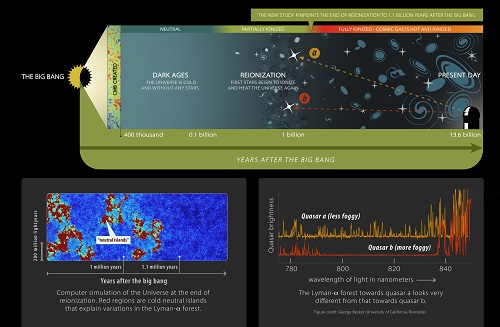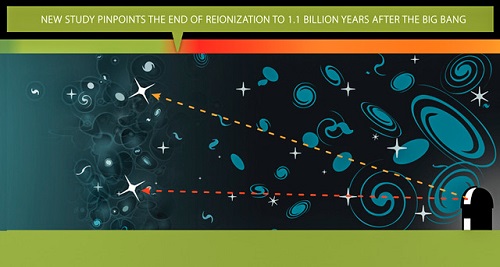
Submitted by Administrator on Wed, 03/04/2019 - 05:11
Large differences in the ‘fogginess’ of the early universe were caused by islands of cold gas left behind when the universe heated up after the big bang, according to an international team of astronomers.
The results, reported in the Monthly Notices of the Royal Astronomical Society, have enabled astronomers to zero in on the time when reionisation ended and the universe emerged from a cold and dark state to become what it is today: full of hot and ionised hydrogen gas permeating the space between luminous galaxies.
Hydrogen gas dims light from distant galaxies much like streetlights are dimmed by fog on a winter morning. By observing this dimming in the spectra of a special type of bright galaxies, called quasars, astronomers can study conditions in the early universe.
In the last few years, observations of this specific dimming pattern (called the Lyman-alpha Forest) suggested that the fogginess of the universe varies significantly from one part of the universe to another, but the reason behind these variations was unknown.
“We expected the light from quasars to vary from place to place at most by factor of two at this time, but it is seen to vary by factor of about 500,” said lead author Girish Kulkarni, who completed the research while a postdoctoral researcher at the Kavli Institute, University of Cambridge. “Some hypotheses were put forward for why this is so, but none were satisfactory.”
The new study concludes that these variations result from large regions full of cold hydrogen gas present in the universe when it was just one billion years old, a result which enables researchers to pinpoint when reionisation ended.
During reionisation, when the universe transitioned out of the cosmic ‘dark ages’, the space between galaxies was filled with a plasma of ionised hydrogen with a temperature of about 10,000˚C. This is puzzling because fifty million years after the big bang, the universe was cold and dark. It contained gas with temperature only a few degrees above absolute zero, and no luminous stars and galaxies. How is it then that today, about 13.6 billion years later, the universe is bathed in light from stars in a variety of galaxies, and the gas is a thousand times hotter?
Answering this question has been an important goal of cosmological research over the last two decades. The conclusions of the new study suggests that reionisation occurred 1.1 billion years after the big bang (or 12.7 billion years ago), quite a bit later than previously thought.
The team of researchers from India, the UK, Canada, Germany, and France drew their conclusions with the help of state-of-the-art computer simulations performed on supercomputers based at the Universities of Cambridge, Durham, and Paris, funded by the UK Science and Technology Facilities Council (STFC) and the Partnership for Advanced Computing in Europe (PRACE).
“When the universe was 1.1 billion years old there were still large pockets of the cosmos where the gas between galaxies was still cold and it is these neutral islands of cold gas that explain the puzzling observations,” said Martin Haehnelt of the Kavli Institute, University of Cambridge, who led the group that conducted this research, supported by funding from the European Research Council (ERC).
“This finally allows us to pinpoint the end of reionisation much more accurately than before,” said Laura Keating of the Canadian Institute of Theoretical Astrophysics.
The new study suggests that the universe was reionised by light from young stars in the first galaxies to form.
“Late reionisation is also good news for future experiments that aim to detect the neutral hydrogen from the early universe,” said Kulkarni, who is now based at the Tata Institute of Fundamental Research in India. “The later the reionisation, the easier it will be for these experiments to succeed.”
Reference:
Girish Kulkarni et al. ‘Large Ly α opacity fluctuations and low CMB τ in models of late reionisation with large islands of neutral hydrogen extending to z < 5:5.’ Monthly Notices of the Royal Astronomical Society (2019). DOI: 10.1093/mnrasl/slz025
Adapted from a press release by Girish Kulkarni (Tata Institute of Fundamental Research)




